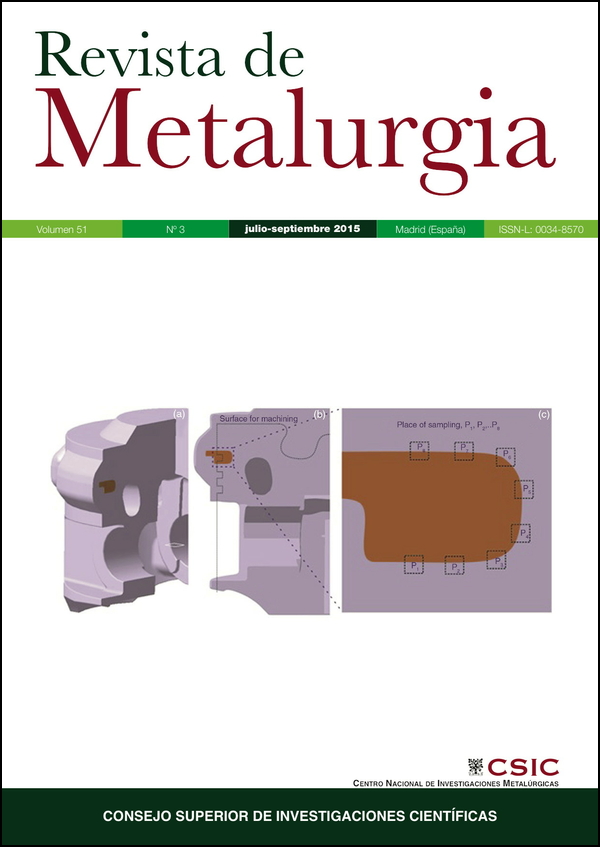Quenching simulation of steel grinding balls
DOI:
https://doi.org/10.3989/revmetalm.049Keywords:
Computer modelling, Heat treatment, Microstructure, SteelAbstract
The phase transformations of high carbon steel during quenching and equalizing were modelled using commercial computer packages based on the finite element method and the kinetic transformation of steel. The model was used to predict the temperature and microstructural changes taking place within balls of two different sizes that are used for grinding mineral ores. A good correlation between the temperatures measured by inserted thermocouples and those predicted by the model was obtained after modifying the thermal conductivity of the steel within the temperature domain at which mixed phases are present. The phase transformations predicted were confirmed by metallographic analyses.
Downloads
References
Aldrich, C. (2013). Consumption of steel grinding media in mills – A review. Miner. Eng. 49, 77–91. http://dx.doi.org/10.1016/j.mineng.2013.04.023
Carlone, P., Palazzo, G.S., Pasquino, R. (2010). Finite element analysis of the steel quenching process: Temperature field and solid-solid phase change. Comput. Math. Appl. 59 (1), 585–594. http://dx.doi.org/10.1016/j.camwa.2009.06.006
Camurri, C., Carrasco, C., Dille, J. (2008). Residual stress during heat treatment of steel grinding balls. J. Mater. Process. Tech. 208 (1–3), 450–456. http://dx.doi.org/10.1016/j.jmatprotec.2008.01.007
Deng, X., Ju, D. (2013). Modeling and simulation of quenching and tempering process in steels. Phys. Proc. 50, 368–374. http://dx.doi.org/10.1016/j.phpro.2013.11.057
Domanski, T., Bokota, A. (2011). Numerical models of hardening phenomena of tools steel base on the TTT and CCT diagrams. Arch. Metall. Mater. 56 (2), 325–344. http://dx.doi.org/10.2478/v10172-011-0036-6
Durman, R.W. (1988). Progress in abrasion-resistant materials for use in comminution processes. Int. J. Miner. Process. 22 (1–4), 381–399. http://dx.doi.org/10.1016/0301-7516(88)90074-9
Ferguson, B.L., Li, Z., Freborg, A.M. (2005). Modeling heat treatment of steel parts. Comp. Mater. Sci. 34 (3), 274–281. http://dx.doi.org/10.1016/j.commatsci.2005.02.005
Guo, Z., Turner, R., Da Silva, A.D., Sauders, N., Schroeder, F., Cetlin, P.R., Schillé, J.-P. (2013). Introduction of materials modelling into processing simulation. Mater. Sci. Forum 762, 266–276. http://dx.doi.org/10.4028/www.scientific.net/MSF.762.266
Krauss, G. (2005). Steels: Processing, structure, and performance, ASM International, Materials Park, Ohio.
Lee, S.J., Lee, Y.K. (2007). Thermodynamic Formula for the Acm temperature of low alloy steels. ISIJ Int. 47 (5), 769–771. http://dx.doi.org/10.2355/isijinternational.47.769
Silva, E.P., Pacheco, P.M.C.L., Savi, M.A. (2004). On the thermomechanical coupling in austenite-martensite phase transformation related to the quenching process. Int. J. Solids Struct. 41 (3–4), 1139–1155. http://dx.doi.org/10.1016/j.ijsolstr.2003.09.049
Varela, A., García, A., Zaragoza, S., Mier, J.L., Barbadillo, F., García, L. (2008). Influencia de los tratamientos térmicos en el comportamiento frente al desgaste por abrasión de una fundición de grafito esferoidal obtenida mediante adición de boro. Rev. Metal. 44 (4), 293–298.
Published
How to Cite
Issue
Section
License
Copyright (c) 2015 Consejo Superior de Investigaciones Científicas (CSIC)

This work is licensed under a Creative Commons Attribution 4.0 International License.
© CSIC. Manuscripts published in both the printed and online versions of this Journal are the property of Consejo Superior de Investigaciones Científicas, and quoting this source is a requirement for any partial or full reproduction.
All contents of this electronic edition, except where otherwise noted, are distributed under a “Creative Commons Attribution 4.0 International” (CC BY 4.0) License. You may read the basic information and the legal text of the license. The indication of the CC BY 4.0 License must be expressly stated in this way when necessary.
Self-archiving in repositories, personal webpages or similar, of any version other than the published by the Editor, is not allowed.
















